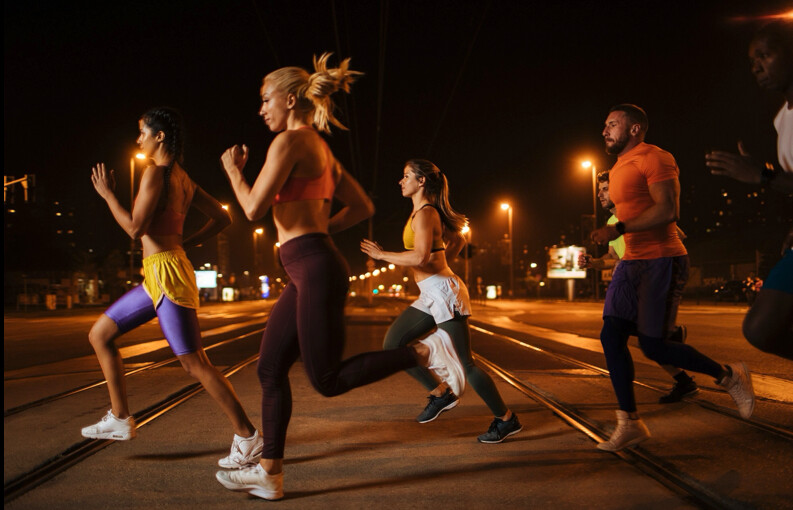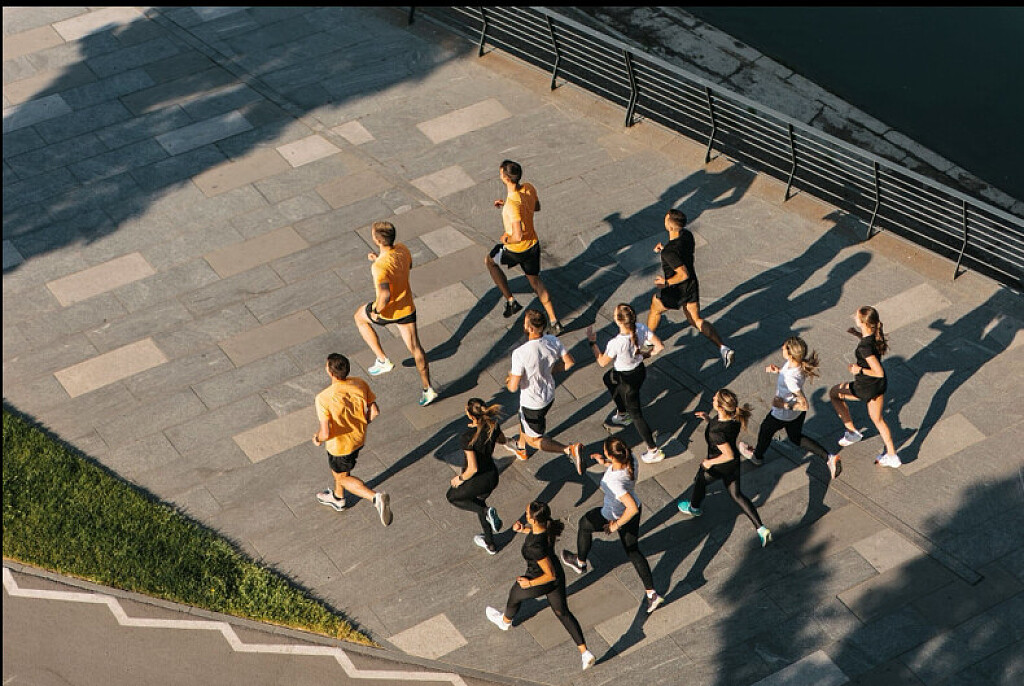Running News Daily
Running News Daily is edited by Bob Anderson in Los Altos California USA and team in Thika Kenya, La Piedad Mexico, Bend Oregon, Chandler Arizona and Monforte da Beira Portugal. Send your news items to bob@mybestruns.com Advertising opportunities available. Train the Kenyan Way at KATA Kenya. (Kenyan Athletics Training Academy) in Thika Kenya. KATA Portugal at Anderson Manor Retreat in central portugal. Learn more about Bob Anderson, MBR publisher and KATA director/owner, take a look at A Long Run the movie covering Bob's 50 race challenge.
Index to Daily Posts · Sign Up For Updates · Run The World Feed
Should You Pick a Run Club to Make Friends or to Run Faster?
Looking to join your local group after run clubs went viral this year? Here's what to know for the best possible experience.
ALL BRENDAN WILSCH wanted was a slightly different running experience. The 23-year-old New Yorker has spent most of his running life hitting the pavement solo, depending on the activity as an outlet to relieve stress. After spending every outing on his own, he decided to branch out and find some company for a change to add some socialization to his workout.

That’s what led him to join the viral run group headed by Lunge, a fitness-focused dating app for which he’d seen promoted posts plastered all over social media. The group showcased hordes of people running the streets, then hitting bars en masse afterwards. To Wilsch, it seemed like a fun way to make friends.

Except the focus on the activity at hand—running—was notably lacking. Wilsch arrived early to the group on a Wednesday evening in July. The group's organizers didn't lead a warmup, so he made time for one on his own. At about 6:50 p.m., the sizable crowd (Wilsch thought about 800 people were there, and an NBC New York broadcast report from July claimed over 1,000 people had RSVP’d to a similar event) was greeted by the run club leaders, Lunge app founder Steven Cole and group fitness instructor Rachel Lansing (Lunge Run Club organizers did not respond to requests for comment on this story). “They welcomed everybody to run club and thanked them for being there and making Lunge turn out to be something bigger than they ever expected,” Wilsch says. “Then they spoke about the app and said, ‘If you see somebody here, and you may not have the courage to go talk to them, download the app, and maybe you'll find them on there.'"
He found that most people in the crowd were outgoing and friendly, even if some seemed hesitant to jump right into mingling mode. After splitting the hundreds of people into a few
This is not how run clubs usually operate, whether they’re in NYC or elsewhere in the world. These groups have broken through run-centric subculture and entered the mainstream; Runner's World notes that Running in the USA lists 968 clubs across the country, and you can find stories about run clubs everywhere from Oakland to rural Australia. Yet it was Lunge that commanded TikTok and Instagram algorithms this summer, especially as young people yearned to meet new friends IRL amidst a “loneliness epidemic.”
There’s some logic to this for outsiders looking in; the groups consist of people sweating and getting their endorphins up doing a healthy activity together. Even better (and unlike group fitness classes at boutique studios or rec sports leagues), clubs are often free to attend or only cost a monthly fee once you become a consistent member training for a specific goal, so you don’t have to worry as much about draining your bank account while simultaneously making a few friends, leveling up your V02 max, and dropping your 5K time.
Not everyone was into this new trend, especially because of what it started to morph into. Apps and groups like Lunge pushed the idea of making
Run Club Best Practices
WHETHER A RUN club prioritizes relationship-building or PR-chasing, it'll almost always have a standard operating protocol that differs greatly from what Wilsch experienced at Lunge. There are rarely groups that large that traverse busy city streets, for one, and most will have more hands-on involvement and organization from leaders to maintain the dynamic beyond show up and jog. The run of show typically includes introductions to the coaches, pacers, and organizers and any need-to-know safety tips or other housekeeping info. Then comes an icebreaker, a warm-up, the run itself (or running workout), a cooldown, hydration, and goodbyes. In commuter cities, there’s also potentially a bag check.
Once runners hit the streets (and even in parks or on public tracks), they shouldn’t just go out in a huge group. There are cars, cyclists, and pedestrians who are on the roads too, and club members will inevitably wind up going at different paces. That’s why many run groups include two kinds of leaders guiding you through the run: pacers and sweepers. Pacers set the tone and time for the group or the smaller groups that break out according to their expected speed
Every run group, whether social-focused or PR-driven, should have structure and safety guidelines (like pacers and sweepers). But run group social dynamics exist on a much more vast spectrum. Some, like Brooklyn Track Club in NYC, are great for prepping runners for races. Others, like Martinus Evans' Slow AF Run Club, focus on inclusivity. Some even affiliate with major brands to allow members to test new gear. In any scenario, bonds are eventually formed by routine and the time spent sharing the experience. It’s a community, and the social dynamics of one persist. Some people like Amir Gamble, a 33-year-old in New York who has been running in the club scene since 2022, join multiple groups. He consistently attends two different runs depending on what he’s looking for—a few miles at a conversational pace to socialize, or focused training and track workouts. He says the groups he’s enjoyed most have established leadership and a welcoming environment, not necessarily the fastest people on the streets.
Gamble’s run sessions are much smaller than Lunge’s massive crowd of nearly 1,000 people. “That’s nearly as many as the race I just did!” he exclaimed, referring to this August’s Brooklyn Mile road race. No matter the organizers’ intentions, he worried about how anyone could safely run on busy city streets and sidewalks in such a large group.
Nearly as pertinent an issue, given Lunge’s stated mission to bring people together, is how hard it actually is to get to no anyone when a run includes hundreds of people. Many run groups count 25 runners max at a normal session, so the workout can start with everyone introducing themselves and participating in an icebreaker activity; it all takes about 15 minutes. When the group swells, that portion of the run requires more time, infringing on the run and your chances at knowing who you're keeping up with on the road. Expecting an immediate connection is like expecting that you’ll set a 10k record the first time you lace up your shoes. Friendships take work.
“Some people chat a little bit after but, usually within 10 or 15 minutes the group kind of dissipates,” Gamble says of his run groups’ social
There are some baseline expectations you should have if you attend a run club. Firstly, the group should center your safety and give you some info about what it takes to be a better runner, according to Zapotechne. “Are they providing electrolytes? Are they helping runners understand what to consider when running in the heat? Or, the safety and etiquette of running in the street in a large group? You run two across [on the street] versus 10,” she rattles off. Even groups without brand partnerships or financial resources should be providing basic running best practice information to their community.
You’ll also want to be mindful of leadership, since you’ll be trusting the coaches with your time and your safety. There are run clubs that are just small groups of friends getting together for a jog and social hour every week without a clear hierarchy—but once the group starts to include people who want to run at different speeds and tackle different goals, it becomes critical that someone takes charge and leads. Ideally, these people have extensive experience with run training and are also actively participating in the run community and culture of the area. Importantly, leaders should also make efforts to establish a safe and inclusive environment within their club. “I think a green flag when it comes to co-ed running groups is when you see both male and female leadership,” Zapotechne says.
Beyond road safety, and with the rise of run club culture via social media in particular, Zapotechne points out the importance of acknowledging boundaries among members. “I did a lot of workshops and training with my staff around what was appropriate and not appropriate, and we had to have (sometimes many) conversations around boundaries when it comes to interactions [with club attendees],” she notes. This includes more obvious things like physically touching, like hugging after runs or unsolicited help with stretching, and murkier territory like when it's inappropriate to send DMs and texts. You should know that if you join a run club and immediately start receiving unsolicited messages—especially from those in charge—something is off. “If you're in a leadership position, you don't slide in the DMs of people that are showing up to your group. That could be a pacer, crew runner, captain or coach. You're not there to date the people who come to your running group,” she says.
A good way to ID a run club that is more focused on sport and movement is to check out the way they communicate their training plans on social media. Do they use terminology like intervals, fartleks
(10/20/2024) Views: 45 ⚡AMPby Men’s Health




